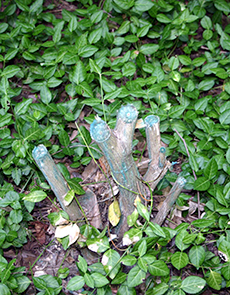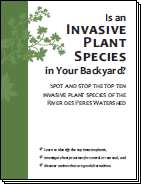Management of Invasives
Invasive Species Management Techniques
- Burning—Conducting controlled burns of the prairie and woodland under specific weather conditions, usually in the fall or winter. Burning works well to control fire intolerant species such as small trees in the prairie, as well as evergreen vines and species that start growing earlier in the season than native species. Burning is a natural process that was once a part of the tallgrass prairie. Restoring this process not only manages species that don’t belong, but also encourages the growth of plant species that do by returning nutrients to the soil, warming the soil, and creating a new habitat structure for animals to utilize. Unburned areas serve as refuges for animals to live in or recolonize burned areas from.
- Mowing—Cutting all the grass and forbs (wildflowers) to about 12 inches with an ordinary lawnmower.This technique works well for annuals (plants that live only one year) because it prevents them from setting seed, and they are eliminated the next year. We frequently use this technique in newly seeded prairie areas, which often have many annual weeds. It also helps increase the survivorship of newly planted prairie seedlings in first year prairies. Mowing does not work well if the species have already set seed, are perennials (plants that live multiple years), or spread vegetatively.
- Hand pulling—Pulling the invasive species up by hand or using trowels, shovels and mattocks.Pulling is best for annuals or perennials with short roots in small isolated areas. When the invasives have set seed, collecting seed heads in trash bags is necessary. We never include invasive species in mulch or compost piles to avoid the possibility of spreading seed or rhizomes. Pulling is very labor intensive, but can be very effective and does not require the use of chemicals.
-

Stumps painted with herbicide. Photo by Jenna Tune. Herbicide—Spraying actively growing leaves or painting cut stumps with herbicide, chemicals that kills plants. The herbicide is absorbed through the leaf or cut stump to the root system, where it kills the whole plant. We ordinarily use glyphosate (Roundup® or similar products) due to its low toxicity, short persistence in the soil, and high effectiveness on a wide variety of plant species. Herbicide is generally a last resort for us. We use it on invasive perennials with deep root systems and invasive species that cover large areas that cannot be controlled by other means. Cutting trunks or stems and painting them with herbicide is often preferable to spraying leaves with herbicide because it is more targeted. Drift from spraying leaves in the prairie or with vines, trees, or shrubs whose leaves grow above our heads would lead to the death of many plants we wanted to preserve. When an invasive species is low-growing and widespread with few other desirable species growing with it, we spray the leaves of the plant with herbicide.
Is an Invasive Species in Your Backyard?
 LREC has produced a brochure detailing identification information and removal recommendations for ten of the most threatening invasive species of the River des Peres watershed. Native alternatives are also listed. You can download the brochure or request a copy from a member of the staff.
LREC has produced a brochure detailing identification information and removal recommendations for ten of the most threatening invasive species of the River des Peres watershed. Native alternatives are also listed. You can download the brochure or request a copy from a member of the staff.